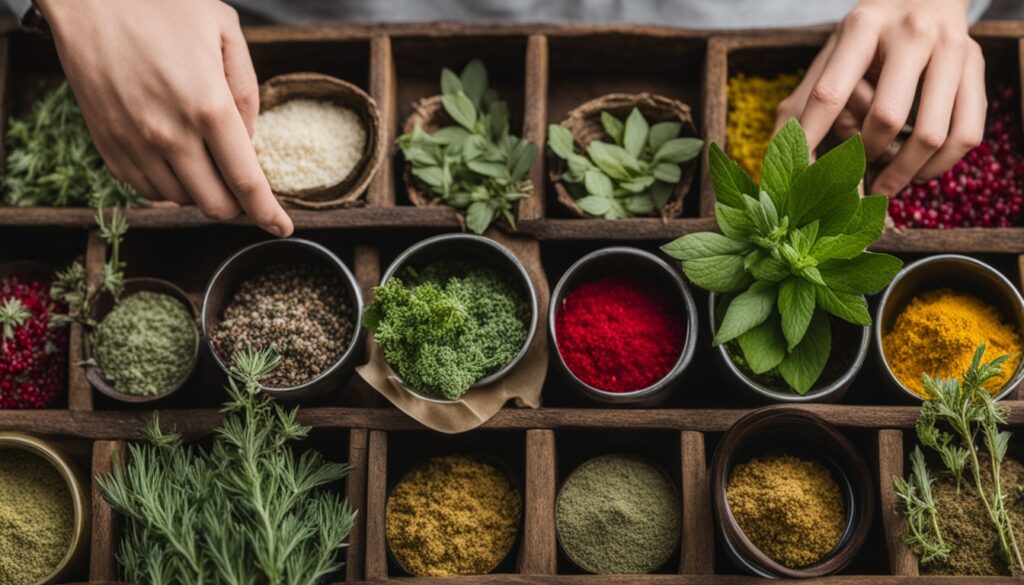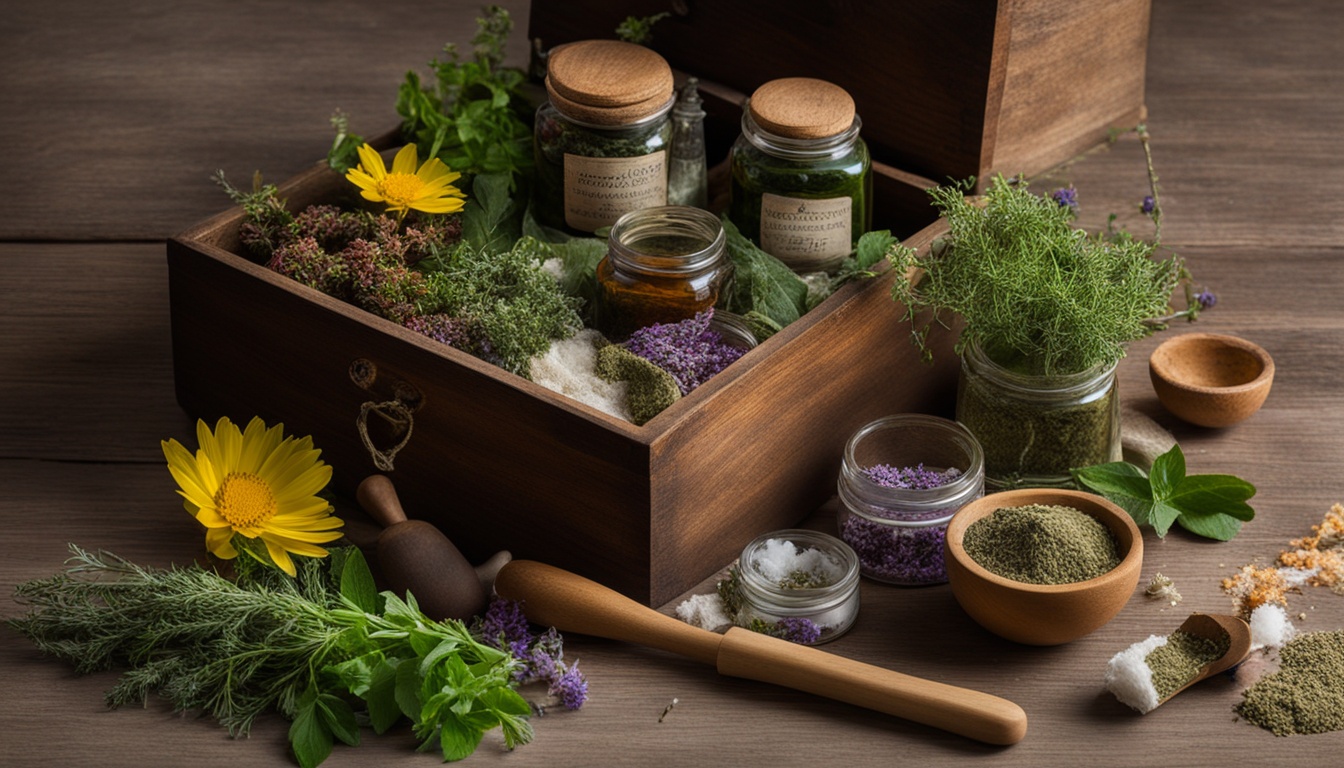Growing your own herbs and making your own remedies can make you feel ready and independent. You can fill your shelves with natural items. This lets you make your own diy herbal first aid kits for your area’s needs.
This guide will help you make a DIY herbal medicine kit. It will mix homemade herbal remedies with some things you can buy. This way, you’ll be ready for small cuts or big outdoor trips.
Key Takeaways
- Cultivate a home herbal emergency kit for self-reliance and natural home remedies
- Customize your herbal first aid kit to address regional health concerns
- Incorporate homemade herbal antibiotics and herbal salves for versatile first aid
- Prepare for outdoor adventures with natural first aid supplies
- Leverage the power of wild harvested plants for herbal remedies
The Importance of a Home Herbal First Aid Kit
Being an herbalist means having a home apothecary ready. It gives you a big sense of being ready and able to take care of yourself. When you can’t get to a doctor or have no medical supplies, a herbal first aid kit with natural remedies can save the day. Make sure your kit is right for your area. This means it should help with things like seasonal allergies, outdoor dangers, or your family’s health needs.
Preparedness and Self-Sufficiency
In today’s fast and unpredictable world, taking care of your health on your own is very powerful. Making a full herbal first aid kit means you and your family have natural remedies when you need them. This kind of preparedness and self-sufficiency gives you a sense of safety and strength. It’s great for times of crisis or when you can’t get to a doctor easily.
Tailoring Your Kit to Regional Needs
A homemade herbal first aid kit is great because it fits your area’s needs. For example, if you live where allergies are common, add herbs like nettle and local honey. If you’re in a place with lots of outdoor activities, put in remedies for cuts and bug bites. This way, your kit is always ready for the health issues you might face.
“A well-stocked home apothecary can provide a true sense of preparedness and self-sufficiency during times of uncertainty.”
DIY Herbal First Aid Kit for Everyday Needs
It’s key to have a good herbal first aid kit at home. It helps with common health issues. Make sure it has remedies for allergies, sinus problems, and eye issues.
Allergy Relief Essentials
Put natural antihistamines like local honey and stinging nettle tinctures in your kit. They help with skin allergies and colds. Also, keep a beeswax-based salve for rashes and hives.
Ear, Nose, Throat, and Eye Remedies
For ear, nose, throat, and eye issues, add mullein ear oil, saline eye drops, and chamomile tea bags to your kit. These plant-based items can ease pain without harsh chemicals.
| Herbal Remedy | Ailment | Application |
|---|---|---|
| Stinging Nettle Tincture | Allergies | Taken orally to reduce inflammation and histamine response |
| Beeswax Salve | Skin Irritation | Applied topically to soothe rashes and hives |
| Mullein Ear Oil | Ear Pain | Dropped into the ear canal to relieve earaches |
| Chamomile Tea Bags | Sore Throat | Placed on the neck or throat to reduce inflammation |
With these allergy relief and ENTE remedies in your herbal first aid kit, you’re ready for many health issues. You can handle them naturally and well.
Gut and Digestion Support
Keeping your gut healthy is key for feeling good. Herbal remedies can help a lot with digestion. They can ease stomach pain and help with constipation.
Ginger is great for your gut. You can eat ginger chews or candies to help with nausea and upset stomach. Chamomile tea is also good. It calms the gut and reduces swelling.
If you have diarrhea, heartburn, or indigestion, bismuth tablets can help. These tablets cover the inside of your stomach. They reduce irritation and help heal.
If you have bad stomach problems or think you might have eaten something bad, activated charcoal tablets are important. These tablets soak up toxins and help with symptoms. They can stop things from getting worse.
| Herb/Supplement | Gut and Digestion Benefits |
|---|---|
| Ginger | Reduces nausea, calms upset stomach, soothes motion sickness |
| Chamomile | Soothes the gut, reduces inflammation |
| Bismuth tablets | Relieves diarrhea, heartburn, and indigestion |
| Activated charcoal | Absorbs toxins, alleviates severe digestive distress |
Adding these herbal remedies to your first aid kit helps your gut and digestion. They keep your body balanced and healthy.
“Gut health is the foundation of overall health, and herbal remedies can be a gentle, effective way to support it.”
Remedies for Illness and Infection
Herbal remedies can help with fevers, coughs, and infections. Elderberry, yarrow, and echinacea are great herbs. They can make colds and flu shorter, lower fever, and boost your immune system.
Fever and Cough Relief
Elderberry syrup is great for cold and flu symptoms. It can make viral infections shorter and help with coughing. Yarrow is also good for reducing fever and inflammation. You can drink it as tea or use it on your skin to break a fever.
Wound Care and Antibacterial Aids
For wound healing and fighting infection, some herbs are very helpful. Lavender essential oil is a strong antibacterial. You can put it on cuts, scrapes, and burns.
Herbal salves and tinctures with plantain, calendula, and St. John’s Wort help with healing and stop bacteria from growing.
“Herbal remedies provide a natural, holistic approach to managing illnesses and infections. By incorporating these plant-based solutions into your first aid kit, you can take charge of your health and well-being.”

Always talk to a doctor before trying new herbal remedies, especially if you have health issues or take other medicines. Doing your homework and getting advice can make sure you use these natural remedies safely and effectively.
Kid and Pet-Friendly Herbal Remedies
When you care for kids or pets, it’s key to have gentle herbal remedies ready. These natural options can ease many common issues. They help with teething pain or paw injuries on the go.
For kids, keep herbal gummies, soothing teething gel, and cute bandages handy. These items make healing fun and help ease pain.
For pets, carry a collapsible water bowl, paw wax, and wrap tape. These items help with injuries and keep pets cool outside. They offer comfort and support when pets need it.
- Herbal gummies for kids
- Teething gel with chamomile and lavender
- Cute bandages with animal designs
- Collapsible water bowl for pets
- Paw wax to protect delicate paws
- Flexible wrap tape for minor injuries
“Herbal remedies offer a gentle, natural approach to supporting the health and well-being of both children and pets.”
Adding kid-friendly and pet-safe herbal solutions to your first aid kit is smart. It ensures your kids and pets get the care they need. And it uses the strength of herbal remedies.
Medication and Pain Relief Essentials
Make sure your home herbal first aid kit has the right medication and pain relief items. Keep extra of any important medicines you or your family take. This is key if you get lost or can’t get to your usual medicine.
For pain relief, have aspirin and nonsteroidal anti-inflammatory drugs (NSAIDs) ready. Also, add herbal remedies like Kloss’s Liniment. It helps with toothaches and bruises.
- Prescribed medications (extra supply)
- Aspirin
- NSAIDs (e.g., ibuprofen, naproxen)
- Kloss’s Liniment (herbal pain relief)
Having the right medicines in your kit means you can feel better and worry less when you need them.
“An ounce of prevention is worth a pound of cure.” – Benjamin Franklin
DIY Herbal First Aid Kit for Outdoor Adventures
When you go outside, make sure your herbal first aid kit is ready for anything. It should have more than just basic home remedies. You need safety and survival items for your outdoor fun.
Safety and Survival Additions
For longer hikes, camping, or other outdoor fun, add these items to your kit:
- Whistle – For signaling in emergencies
- Flares – To alert rescuers of your location
- Water filtration system – Ensure access to clean, potable water
- Extra food rations – In case you become stranded or lost
- Bear spray – For protection against wildlife encounters
- Emergency blankets – To retain body heat in cold weather
These items will help keep you safe and alive during your adventures.
| Item | Purpose |
|---|---|
| Whistle | Signaling for help in emergencies |
| Flares | Alerting rescuers to your location |
| Water Filtration | Ensuring access to clean, drinkable water |
| Extra Food | Providing sustenance if stranded or lost |
| Bear Spray | Protecting against wildlife encounters |
| Emergency Blankets | Retaining body heat in cold conditions |
Adding these important safety and survival items to your herbal first aid kit will help you face outdoor challenges.
Wildcrafting and Using Wild Plants
Using nature’s pharmacy can change the game for making a good herbal first aid kit. Wildcrafting is the art of finding wild medicinal plants the right way. Plants like yarrow and plantain can help with many health issues. They also cut down on the need for synthetic medicines.
But, be careful with wildcrafting. It’s important to know which plants you’re picking. Make sure you don’t mix them up with harmful ones. Learn all about the plants you use in your remedies.
When you pick these plants, do it in a way that helps the environment. Only take what you need and let the rest grow. This keeps nature healthy and makes sure these plants will still be there later.
Start with wildcrafting and see how amazing wild plants can be for your herbal remedies. With some knowledge and respect for nature, you can make a first aid kit that really works. It will help you in many situations.
“The riches of the wilderness are not for those who merely visit, but for those who live within it.”

Herbal First Aid Recipes
Use nature’s remedies with these DIY herbal first aid recipes. They can help with many common health issues. You can make topical treatments and internal elixirs at home.
First Aid Poultice
A poultice made from herbs can be very helpful in first aid. It stops bleeding, reduces swelling, and fights infection. Mix crushed herbs like comfrey, plantain, and yarrow with moist plant material.
Put the paste on the wound and cover it with a clean cloth.
Headache Oil
Make a headache oil to ease tension headaches and migraines. Mix 2 tablespoons of coconut oil with 5 drops each of lavender, peppermint, and marjoram essential oils. Massage it on your temples, forehead, and neck for quick relief.
Burn Rescue
For burn relief, use a mix of aloe vera and lavender. Combine 1/2 cup of fresh aloe vera gel with 10 drops of lavender essential oil. Put it in a clean glass jar.
Apply this on burns to reduce redness and swelling right away.
These herbal first aid recipes are for minor injuries and issues. Always see a doctor for serious or ongoing health problems.
Conclusion
Making your own herbal first aid kit is a great way to take care of your family. You can mix old natural remedies with things you buy to make a kit just for you. This way, you’re ready for many health issues, like allergies or outdoor injuries, with safe, natural ways.
Need relief from a cold, or taking care of a sunburn or small cut? Your herbal first aid kit will be very useful. Using plants helps you take care of your health and connect more with nature.
Keep learning about herbs and improving your first aid kit. The journey of learning and trying new things is just as important as the end result. With some effort and time, you’ll be able to handle small emergencies with your herbal first aid kit.
FAQ
What are the benefits of having a DIY herbal first aid kit?
What should I include in my everyday herbal first aid kit?
How can I make my first aid kit suitable for outdoor adventures?
Can I use wild medicinal plants in my first aid kit?
What are some DIY herbal first aid recipes I can include in my kit?
Source Links
- Make an Herbal First Aid Kit – https://www.whollyrooted.com/blog/herbal-first-aid-kit-dayweekend-prep
- Making Your Own Natural First Aid Kit — Green Path Herb School – https://www.greenpathherbschool.com/greenpathblog/making-your-own-natural-first-aid-kit
- My Natural First Aid Kit & Remedy Cabinet – https://wellnessmama.com/remedies/natural-first-aid-kit/
